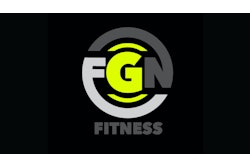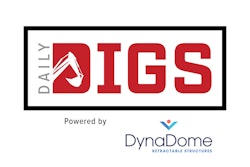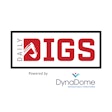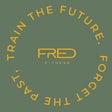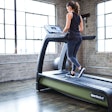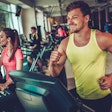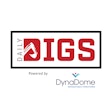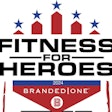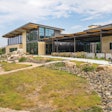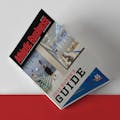Exercise testing, according to ACSM standards, should be part of all members' initial assessments upon joining your facility.
WITH THE RELEASE of the new 7th edition of ACSM's Guidelines for Exercise Testing and Prescription, it is timely and important to review the steps to perform a complete health and fitness assessment. Many in the health/fitness industry may have moved away from incorporating the assessment process when assimilating new members; however, to ensure members' safety and well-being, and to improve member retention and programming, assessments must be performed. Further, assessments provide both the members and facility personnel with the means to document improvements attained through participation in an individualized, well-designed, regular exercise program.
Following is a step-by-step review of the health assessment procedure according to American College of Sports Medicine (ACSM) standards, along with how to interpret test results and strategies for more effectively incorporating the health assessment process into your facility.
A couple of notes: Web listings have been included as a quick reference for testing procedures and interpretation; however, the most timely information is published in ACSM's Guidelines. Also, the assessments described here are comprehensive for whom ACSM terms a "low risk" individual. Members who are at moderate to high risk for cardiovascular disease, also described by ACSM, may require additional medical evaluation prior to engaging in physical activity.
Pre-test instructions and the test environment
Members should be instructed to arrive for their fitness assessments wearing the proper clothing, having avoided significant exertion or exercise on the day of the test, and having abstained from food, alcohol, tobacco and caffeine for three hours prior to testing. They also should have been given some information regarding the assessment so they have reasonable expectations and can plan the rest of their day accordingly.
When possible, testing should be conducted in a quiet, private area to reduce anxiety and improve concentration. Practically speaking, it may be feasible to only complete the questionnaires, and height, weight, resting heart rate, blood pressure and body composition assessments in such a place. The remaining tests, including cardiorespiratory endurance, muscular fitness and flexibility assessments, will most likely occur on the facility floor.
The staff member conducting the tests should be relaxed, yet confident, to ease the member through the screening process. Testing procedures should be explained clearly, and ample time should be allowed to answer any questions. The process should be conducted in an organized fashion. Sometimes it may be necessary for members and staff to perform the entire screening process in the span of two days; the resting assessments on day one, followed by the active assessments on day two.
Components of the health screening
For individuals seeking a professionally guided exercise regimen, the general components of the health assessment process are broad in nature, and range from evaluating the many components of physical fitness to protecting your facility from liability. The tests and components should be performed in a specific order, and include the following:
6. Flexibility
As noted, these tests may be divided into resting assessments (tests one, two and three) and active assessments (tests four, five and six). For certain individuals, however, the risks of exercise testing may outweigh the benefits associated with exercise. Exercise testing without a physician present may be contraindicated for a person with conditions such as acute infections or unstable chest pain (angina). A complete list can be found in ACSM's Guidelines. If defined by the ACSM/AHA Questionnaire, have your member obtain a physical examination and medical clearance (www.exrx.net/Testing/PhysicianLetter.html) prior to testing.
The initial steps in the assessment process are aimed at obtaining a comprehensive understanding of your new member's health and lifestyle. Central to this information is completion of all necessary health/facility forms, and the determination of resting heart rate and blood pressure. Members should complete the forms (e.g., ACSM/AHA Questionnaire or PAR-Q, questions regarding past and existing health conditions and risk factors for cardiovascular disease, informed consent, etc.) that will provide information regarding whether it is safe to test them in your facility prior to scheduling a fitness assessment appointment. If a red flag, such as frequent chest pain, arises in your pre-test evaluation, now is the time to recommend physician intervention.
Following is where you can obtain examples of these forms: PAR-Q (www.csep.ca/pdfs/par-q.pdf); informed consent (www.exrx.net/Testing/InformedConsent.html); CAD risk factor analysis (ACSM's Guidelines).
The informed consent should be approved by your legal counsel to determine the appropriate language and consent process for your facility. Forms to evaluate medical history and lifestyle behaviors should also be considered, and can easily be developed.
Resting heart rate and blood pressure
Determination of resting heart rate (RHR) and resting blood pressure (RBP) should, ideally, be conducted after the member has been allowed to sit quietly for five minutes. Practically speaking, members may complete health/fitness assessment forms during that time, if they haven't already. The most common method for determining RHR is the radial palpation technique. While the subject is seated, palpate the radial artery at the base of the thumb (lateral to the mass of wrist tendons) using your index and middle fingers. Count the pulse for a period of 10 seconds and multiply by six. Record the results in beats per minute (bpm).
To determine RBP, wrap the cuff firmly around the upper arm at heart level, aligning the cuff with the brachial artery. The appropriate cuff size will be ensured when the bladder within the cuff encircles at least 80 percent of the member's upper arm (most adults will use a large cuff size). The stethoscope bell is placed below the antecubital space over the brachial artery, with the bevel on the earpieces facing toward the front. Rapidly inflate the cuff 20 mmHg above the first Korotkoff sound, and then slowly release pressure at a rate not exceeding 5 mmHg per second. The first sound heard represents systolic blood pressure (SBP). Continue to release pressure and note when the sound becomes muffled and then finally disappears. Just prior to when the sound disappears is used for classification of diastolic blood pressure (DBP). A minimum of two measurements, separated by one minute, should be taken, with the results and goals explained to your member.
Values < 120 mmHg for SBP and < 80 mmHg for DBP are considered normal Values between 120 and 139 mmHg for SBP or 80 and 89 mmHg for DBP are categorized as prehypertension SBP values between 140 and 159 mmHg or DBP values between 90 and 99 mmHg is stage 1 hypertension SBP values 160 mmHg or values 100 mmHg for DBP places an adult in stage 2 hypertension
Body composition
Body composition describes the relative proportion of fat to fat-free mass. Excess body fat places an individual at increased risk for development of diseases such as type 2 diabetes, stroke and hypertension. A number of laboratory and field techniques have been developed to assess this important component of physical fitness.
A common and reliable field method, which correlates well to hydrostatic weighing, is to estimate body composition from skinfold measurements. The skinfold technique is based on the fact that subcutaneous fat is proportional to the total amount of body fat. It provides a reliable estimate of your member's body density, which is used to determine percent body fat. This relationship, however, depends considerably on your member's age, gender and ethnicity. Population-specific equations to convert body density to percent fat reflect these variables.
* Rotate through measurement sites to ensure the skin has time to return to normal.
A standardized description of skinfold sites can be found in ACSM's Guidelines or at www.exrx.net/Testing/BodyCompSites.html. The skinfold sites used are dependent on the generalized skinfold equation that converts skinfolds into body density. Such equations to convert skinfolds into body density can be found in ACSM's Guidelines. A common equation includes the chest, abdomen and thigh (men), and triceps, suprailiac and thigh (women) skinfolds. As noted, population-specific equations are then used to convert body density into percent body fat. Computer programs (www.exrx.net/Calculators/BodyComp.html) have made the task of converting skinfold measurements to percent body fat much easier, or consult ACSM's Guidelines for the manual process. The average body fat for men and women varies, dependent on age (see ACSM's Guidelines or consult www.exrx.net/Calculators/BodyComp.html).
ACSM also recommends measurement of waist circumference, since body fat distribution, particularly in the abdomen, is an important predictor of a number of health risks. Measurements should be made with a flexible yet inelastic tape measure placed lightly (avoid compressing the skin) at the narrowest part of the torso above the umbilicus and below the xiphoid process. This process should be repeated until duplicate measures are within 5 mm. Waist circumferences <70 cm in women and <80 cm in men are considered low risk for associated health risks (CAD, hypertension, type 2 diabetes, etc.). See ACSM's Guidelines for a complete list of waist circumference classifications.
Cardiorespiratory endurance
Cardiorespiratory endurance is the ability to sustain dynamic, vigorous-intensity exercise using large muscle groups. This type of exercise depends on the ability to consume (respiratory system), transport (cardiovascular system) and use (skeletal muscle) oxygen efficiently. The greater the efficiency of these systems, the higher the VO2max. Generally, a person with higher cardiorespiratory fitness has a reduced chance of death from all causes.
Most often, it is more practical to perform a submaximal exercise test and predict VO2max, rather than a maximal exercise test, which requires increased management and supervision. Stationary cycle ergometers and motor-driven treadmills are common modes to test aerobic capacity, as numerous protocols exist for each. If your member has not been classified as contraindicated to exercise, follow these general procedures for submaximal testing of cardiorespiratory endurance:
* Conclude the test when HR and BP stabilize, although not necessarily to resting levels.
As mentioned, numerous protocols exist to determine cardiorespiratory endurance. Refer to pages 70 to 74, or 100 to 101 in ACSM's Guidelines for a comprehensive review of cycle ergometer and treadmill tests. Also, the YMCA cycle ergometer protocol can be found online at www.exrx.net/Testing/YMCACycleTest.html, and the popular Bruce treadmill protocol can be found at www.exrx.net/Testing/CardioTests.html.
Once the test is completed, it is appropriate to determine members' VO2max using prediction equations. Consult Appendix D of ACSM's Guidelines for information on how to calculate treadmill VO2max, or refer to www.exrx.net/Calculators/YMCACycle.html for computer-generated results of the YMCA cycle test. Your members may now be ranked into a percentile value of the appropriate population (age) based on their VO2max value. Such information also provides a baseline to monitor improvements upon retesting after cardiorespiratory endurance training. Percentile values for VO2max can be found on page 79 of ACSM's Guidelines, or at the above Internet sites.
Muscular fitness
* When comparing a member's strength assessments to other individuals, results should be expressed as the weight lifted per unit of body weight (e.g., kg/kg).
Dynamic muscular strength (upper and lower body) is frequently assessed using the one-repetition maximum (1-RM), or the heaviest weight that can be lifted one time. However, performing a battery of 1-RM tests may prove to be impractical and/or increase associated risks. Tests of muscular fitness may be substituted by choosing a submaximal level of resistance, and counting the maximal number of repetitions before fatigue. The appropriate weight (and exercise) may be based on a percentage of 1-RM (estimated 6-RM or 10-RM) or body weight (e.g., 70 percent). After strength training, the same initial weight would be used to reassess muscular fitness of a particular muscle.
3. Record the maximal number of push-ups performed as that person's score.
For the curl-up (crunch) test of abdominal strength, all members assume a supine position, with a 90 degree bend in the knees. The arms are placed at the side with the fingertips in contact with tape placed on the floor. A second piece of tape is placed 10 cm distant from the first. Members should do the following:
3. Your member's score reflects the total number of curl-ups performed without losing pace with the metronome up to a maximum of 25.
Variations do exist on how to perform the curl-up test, and may be found in ACSM's Guidelines. Norms for the push-up and curl-up tests may also be found in ACSM's Guidelines. Also, refer to www.exrx.net/Calculators/PushUps.html or www.exrx.net/Calculators/ SitUps.html for an easy method of determining a member's population ratings.
Flexibility
Flexibility is the ability to move a joint through a full range of motion. It depends, in part, on the muscles, ligaments and tendons surrounding the joint, the degree of warm-up and the type of joint in question. Flexibility is an often-neglected component of physical fitness, and those who are inflexible may be at higher risk for injury during activity, and/or lower-back pain.
5. Record the most distant of two trials (in inches or centimeters) as the score.
Percentiles for the standard test are based on gender and age, and can be found on page 90 of ACSM's Guidelines. Also, refer to www.exrx.net/Calculators/SitReach.html to determine your member's population rating for the YMCA Sit-and-Reach Test.
Conclusions
Exercise testing is not an end in itself, but, rather, should be integrated into the assimilation of new members and their overall exercise program design. Assessments can be performed in a time-efficient manner that is safe and practical. There are numerous ways to use the testing experience to help educate your members, as in determining, for example, a member's 10 RM as part of an effort to design a circuit-training program. Through testing, you can maximize your ability to tailor a safe, effective program for each individual member. Further, by establishing a performance baseline, tangible evidence is gathered that can later be used to document fitness improvements attained through training. Such individual attention to your members' initial fitness level will not only aid in exercise programming, but, perhaps, will standardize the industry assimilation process, and increase overall member retention and fitness center profitability. FM



















